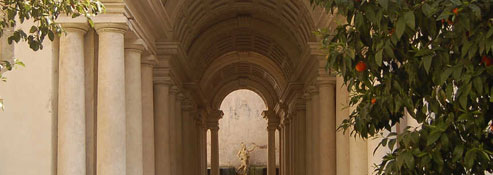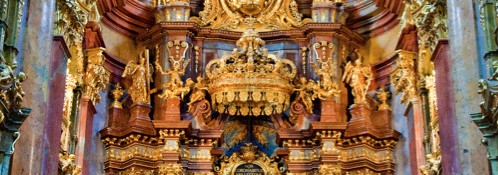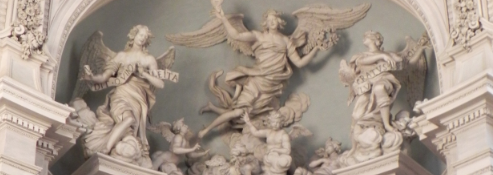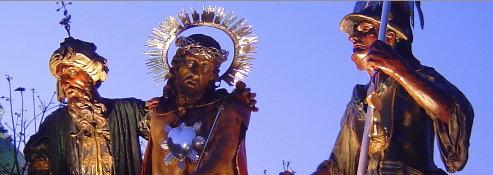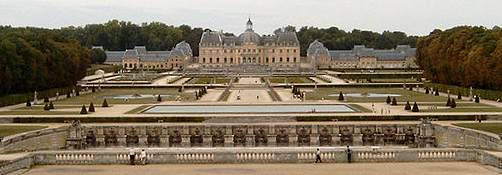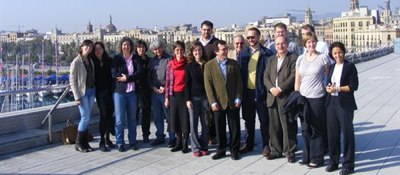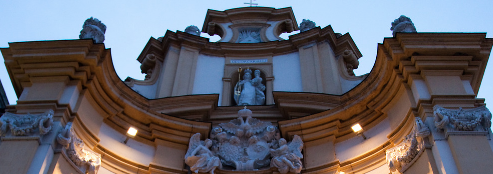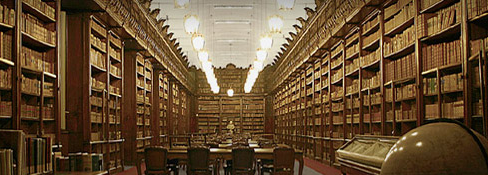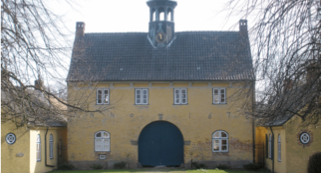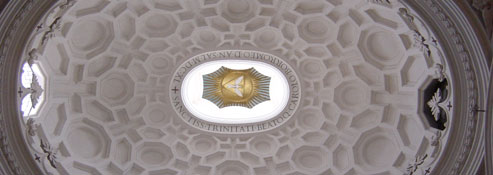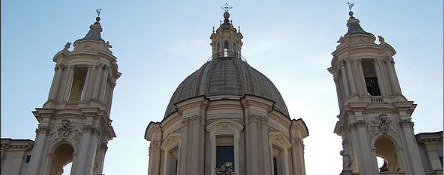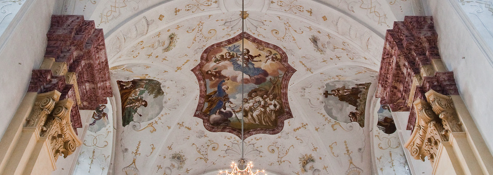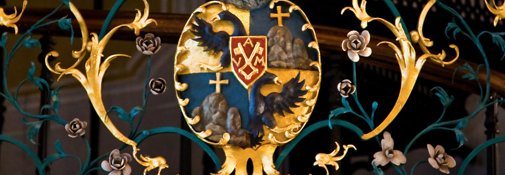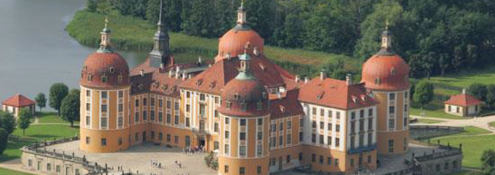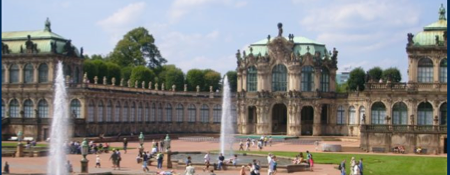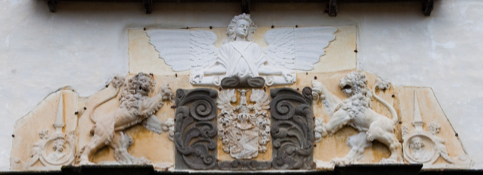1. Italian historiography first began to open up the question of courts at the end of the 1970's, thanks in part to the activity of an association, the Centro studi "Europa delle Corti" that included scholars from various disciplines and hailing from different Italian universities. The origins of the association date back to October 1976, to a conference that was devoted to the Farnese courts of Parma and Piacenza. The Centre set itself the goal of launching an important research project that would bring together historians of literature, theatre, art, music, as well as historians tout court for the purpose of studying Italian Renaissance Courts and, in a wider sense, the courts of the Ancien Régime, while at the same time acquiring a formal identity for itself. As result, on June 14, 1979 a stable institution came into being, one that had no particular affiliations with any academic bodies and resembled more a loose network comprising various interconnected areas of expertise and disciplines with a focus not only on Italy, but as its name suggests, on Europe. The centre's first president was Paolo Prodi and it began to publish an edition of books that was published in Rome by Bulzoni - the Biblioteca del Cinquecento. At the beginning of the 1980's it proposed the creation of the Istituto di studi rinascimentali di Ferrara which was later founded in 1983 and which itself launched a journal (still appearing) entitled "Schifanoia" published by Panini in Modena. Adriano Prosperi, the first director of the Ferrara Institute, introduced the project in the pages of "Schifanoia" and justified the choice of Ferrara as "not an accidental setting for an initiative on the Renaissance". He recalled the "illustrious precedent" of the Ferrara "Centro di Studi Rinascimentali" which had been established in 1956 and had included the likes of Gertrud Bing, Delio Cantimori, Eugenio Garin, Frances Yates among others1. Prosperi went on to explain that unlike the 1956 Centre, the 1983 Institute aimed to take in a vaster area - that of the Po states and not just the court of Ferrara and that the period to be studied would not be narrowly confined to the Renaissance but would run from the fifteenth to the eighteenth centuries. The result was that the project was very "European" in its scope, though it initially remained very much circumscribed to the Po Valley as well. In terms of its chronology, it focussed mainly on the Renaissance - and what else could we expect given its interest in the phenomenon of courts? Nonetheless, it considered the Renaissance to be a testing ground for a more general interpretation of the Ancien Régime.
I believe it is important to examine the internal history of the group Europa delle Corti, of the Biblioteca del Cinquecento, of the Ferrara Institute that was associated with it, as an investigation into how a particular research project was organised: for example, one might look at when individual scholars joined or left the project, and the places and subjects of periodic conferences.
In order to grasp the project's cultural significance, we must, of course, first contextualise it among the currents of Italian historiography of the last century. During the postwar years when democratic Italy was in the process of being reconstructed amid bitter political and ideological clashes, Italian historians (who were a much tinier academic group than they are today) tended to orient their research towards topics whose choice implied an interpretative stance on the great questions of the modern and contemporary world; topics such as the transition to capitalism, the modernization of the state, the role of intellectuals in relation to ruling power. It was around such themes that the debates on ethical-political historiography (the Crocian paradigm) and on the Gramscian interpretation of Italian history revolved. Basically, the entire course of Italian history from the Middle Ages to fascism was being called into question, while historians aimed to determine the limits that had held back the Risorgimento and the process of unification2. Debate on categories such as the late 18th century notion of passive revolution (Vincenzo Cuoco), or Gramsci's more recent interpretation of the Risorgimento as a failed agrarian revolution took place in a lively climate of exchange which at times was even bitter and which ultimately led to a revision of the history of the Italian peninsula before and after unification. According to the prevalent historiographical canon of the 1950's and 1960's, Italy's political fragmentation in the early modern age, the Spanish hegemony, the decadence in the forms of urban and cultural life during the 17th century under the twin burdens of economic decline in the Mediterranean and the Counter Reformation were all parts of a picture in which courts were seen in a negative light, a phenomenon that historical researchers did well to shun unless for the purpose of pointing out its undesirable effects on the nation's history. This view that Italy's decadence could be traced back to the late 17th and 18th centuries has since come under criticism, but in the last century it was just historiographical common sense3. For example, it was no coincidence that in the decades following unification, a number of studies appeared dealing with the Roman court which was thought to be the epitome of backward and corrupt practises, an icon of dissimulation cloaked by religion, tainted by the double "sin" of being both a court and the expression of the same papal power that had opposed the creation of the Nation State.
In this context, the project "Europa delle Corti" was breaking with a historiographical tradition and taking up a decidedly revisionist position. A useful text in support my view is Cesare Mozzarelli's long essay entitled, Principe e Corte nella storiografia italiana del Novecento, appearing in a volume edited by the author himself along with Giuseppe Olmi (the twenty-first in the series) in La corte nella cultura e nella storiografia. Immagini e posizioni tra Otto e Novecento. Mozzarelli shows how this negative view of courts had long roots in the culture of the 19th century (but one might indeed trace it all the way back to the Enlightenment and observe how the motif of the "anti-court" had been ever present from the very origins of the phenomenon of the court). He also draws attention to the fact that the dichotomy between modern State and court was motivated by ideology and to the supposition that the court was a place where one served the prince but not where politics were practised.
Mozzarelli writes:
If the court has come to be considered as antithesis and complement to the modern state, if the very notion of the modern state has allowed itself to be defined thanks to the creation of a negative pole - courts, feudal vestiges etc....to which everything might be ascribed that was not modern and not rationale, in short, if a study of the origins of modern politics and the forms of power has been radically ideological, then an examination of the court outside this ideological framework might be a way to reopen discourse both on the power and politics of today and on the entire field of modern history4.
Another aspect of the intellectual climate of Italy in the early 1980's, when Italian historians were just beginning to look at courts, was their great openness to influences from the social sciences and the historiography being done in France. At the end of the 1970's Nobert Elias' masterly interpretation of the society of the courts, on the role of good manners in the development of a paradigm of civilité, on the disciplined regulation of violence through the gradual differentiation in the functions of social groups and the controlled interplay of social relations established itself as a central theme in European debate in the human sciences, above all in France, thanks to scholars like André Burguière and Roger Chartier. Elias work Über den Prozess der Zivilisation was published in Germany in 1939 (in Basel) and republished in 1969 with a methodological preamble. Later it was translated into French by Calmann-Levy in two separate volumes that appeared two years apart - La Civilisation de moeurs (1973) and La Dynamique de l'Occident (1975) a hiatus that certainly did not make what was intended to be a single work any easier to understand. Die höfische Gesellschaft whose first edition appeared in 1969 but which took up previous material from Elias' German period was later published by Calmann-Levy in 1974 under the title La Societé de Cour. Almost a decade passed before Elias' trilogy was translated into Italian by the publisher Il Mulino, first Die höfische gesellschaft in 1980 with an introduction by Alberto Tenenti, then in 1982 La civiltà delle buone maniere, the first of the two volumes of Über den Prozess der Zivilisation with the introduction by Elias himself (which is missing in the French translation) drafted in Leicester in 1968, and finally, a year later in 1983, the second volume with the title Potere e civiltà . On more than one occasion scholars have pointed to the ambiguous aspects of this late introduction into Italy of a general theory of western civilisation that combined the methods and categories of German sociology with Freudian psychoanalysis. While Elias profoundly affected French historiography at a time when the school of Annales was redefining itself, this same school of historiography provided the vehicle through which Elias' work reached Italy, where he was read, improperly so, alongside the works of Ariès and Foucault. This is not the place to trace the development of Elias' reception in Europe5. I would only venture to ask a question which has a bearing on these pages, one that I think is unavoidable: to what extent during the 1980's was Italian historiography on the courts influenced by the translations of Elias.
To be sure, Elias' argument that the organisation of the society of the court could be considered indicative of a more general process of civilisation in the west also served to confirm Italian historians in their discovery of the phenomenon of the court. It also provided impetus to a new current of scholars who straddled the fields of history, law, anthropology and art, spawning seminar groups such as "Il Laboratorio della Storia" coordinated by Sergio Bertelli. But this would be taking a superficial view of his influence. In reality there existed a profound gap between Elias' sociological model - which he developed in the context of European culture during the 1930's - and applied to the great Baroque court of Versailles - and the work being done in Italy that dealt with different models of small courts that had very different kinds of chronologies, spatial contexts and citizens: the Po valley courts, the Medici court, the Savoia court. Tenenti drew attention to this gap in his penetrating introduction to the Italian edition of La società delle corti. Without impugning the value of Elias' work Tenenti observed how, for Elias, the court "does not correspond to the complex structure that was propping up France but almost exclusively to the mutual behaviours of courtiers and the monarch"6. Tenenti maintained that by limiting the concept of interdependence to a restricted milieu, Elias had laid less importance on other types of relationships. In support of this, Tenenti affirmed that it was no coincidence that "Colbert [was] mentioned only once and his influence equated or likened to that of certain of the Sun King's favourites"7. He concluded by asking how far could Elias' method and results be applied to other models8. Tenenti's introduction should be read together with the preamble he wrote during roughly the same period for the first volume in the series Biblioteca del Cinquecento to which we shall return shortly. This distance between Italian historiography and Elias was also repeated by Giuseppe Olmi and Cesare Mozzarelli in their introduction, as co-editors, to the already mentioned volume of 19839, and by Mozzarelli again in the paper he gave at a conference organised by the CNRS and by the École Française which was held in Rome in October a year later and entitled Culture et idéologie dans la genèse de l'état moderne - part of a French multi-year research programme on the State. Mozzarelli's paper began very polemically and I would like to quote from it:
Only a few years ago, a paper about the court in a conference devoted to the rise of the modern state would have appeared inconceivable. What is the court for historians if not the antithesis of the 'Modern State'? The latter has to do with order, rationality, progress and power, while the former is about disorder, irrationality (luxury, intrigue, immorality), decadence (of politics and of men), impotence (of the prince's government) [...] Then Elias came along and the court became a different kind of place, an experimental space from which to test the iron laws of interpersonal relationships, the interdependency between dominators and the dominated, an organic system where tout se tient comprising the "private", "social" and "political". And so, the certainty that progress, order and rationality there are and have only one name [...] restores its sheen and confidence10.
In Mozzarelli's view, by assuming the hypothesis that the structures of "civilised" behaviour are closely connected to the development of the State in western Europe, and by linking the socio-genesis of the State to the repression of drives and the interiorization of constraints, Elias was suggesting that European society had developed along a clearly linear pathway, what amounted to a parallel history of modernization, a history that was based not on politics and economics but on psychology and sociology, indeed, on anthropology11. Later again Mozzarelli, a key figure in the Centro Europa delle Corti, during a conference he co-organised with Gianni Venturi in Trent in 1988 dealing with the system of courts on the eve of the French Revolution, remarked in a brief note to the paper he gave on the Lombard nobility in the age of Maria Theresa, how historians in Italy had also changed their perspective over the previous two decades when looking at the relationship nobility- court: "after the great amount of work done above all by the Centro Europa delle Corti and in the light of the parallel, though largely alternative influence of studies of Nobert Elias12.
I could refer to many other texts that would show how in Italy the historical study of courts developed independently of Elias' influence and a logical result of this was that the general distancing from Elias that occurred during the 1990's was less bitter in Italy, in fact almost absent. When in 2000 the journal "Storica" undertook to test the efficacy of Elias' model by empirical research they invited a non-Italian, Jeroen Duindam13, author of the well known work Myths of Power. Nobert Elias and the Early Modern European Court (Amsterdam 1994), and scholar of the courts of Versailles and Vienna.
The deconstruction Elias' model, a process in which Duindam was not the only participant, was also the effect of empirical research, above all, in the English speaking world14, of the establishment of an approach based on network analysis, on the widespread use of the category of patronage - political and artistic - of a return by both historians and anthropologists to the theme of royalty as power represented through discourse, rites, images, and finally of the relativization of the paradigm of modernity. This latter question, together with the question of the central State, both key components of Elias' work, should also be considered in view of the wider methodological and theoretical relationship that exists between empirical research and the production of strong interpretative models. The court is not the only case in point. Another example is the complex problem of applying the category of the public sphere - in the wake of Jürgen Habermas' theories - to the history of books and read-ing: a topic that is not unrelated that of the court - itself having largely to do with political discourse on modernity. Habermas, who published his thesis in 196215, does not mention Elias, but posits a discontinuity between what he calls the representative public sphere, where he locates the humanistic cultural world that was integrated in the life the court, and the bourgeois public sphere, not a continuity as it is assumed to be in the work of Elias.
2. Let us return to Italian historiography and develop the second point of this paper by attempting to answer the question of which areas have been most explored by Italian scholars of the courts since the 1970's and what have been the most enduring results of their efforts. An initial and original area of investigation was the work done on texts, among which Castiglione's Courtier occupies a notable place. The perspective adopted by these studies viewed the court as a complex system founded on the cultural codes of "grazia" and "sprezzatura", on a courtly grammar that was expressed in Castiglione's text and from which a knowledge and practises arose that spread over modern Europe and acquired a significance of vast proportions. This textual approach was launched in a seminar held in October 1978 marking the 500th anniversary of Castiglione's birth in Casanatico di Macaria, and its proceedings were published in 1980 in two volumes. In the various essays The Courtier is presented both as the historical product of a precise set of circumstances in 16th century Italy, and as a foundational or seminal work, a fertile matrix for a series of subsequent discourses on the court16. In his introduction to the 1981 edition of The Book of the Courtier17 Amedeo Quondam interprets the work as a lucid manifesto, an "archtext", presented as the trunk of the arbor textualis that "forms", in the Aristotelian sense, through the use of words, "the real features of the court".
Quondam writes:
It [The Courtier] takes on the proportions of an anthropological manifesto and traces out the boundaries of a highly important and enduring semiotic field (an authentic typology, a modelization) that gave rise to - above all - other sets of discourses and other, even partial grammars: for example, those that were specifically related to the Galateo or the Civil conversazione (and it is certainly symptomatic that these two texts were closely connected to The Courtier in their reception in Europe) or that very vast sector of treatises on the dance, games, duels, hunting, horses, dressing, eating, on secretary...18
This interest in texts, their history, their reception and fortunes has been a constant feature of the editorial work of the Centro Europa delle Corti. It has resulted in the editing of other texts that were "complementary" to The Courtier19 and survey studies on works of indisputable importance such as Stefano Quazzo's Civil conversazione also considered in its Po Valley context20, or the Oráculo manual y arte de prudencia (1647) by Baltasar Gracián which has restored a "Jesuitical" or Spanish version of the Courtier21. But often the Centre's work on texts also spanned out into multifaceted analyses of single authors considered to be "foundational" such as Giovanni della Casa22 or studies of treatises, such as books dealing with good manners23 or economics24 or duels25 (an area to which Claudio Donati26 has made a substantial contribution), or on chivalry27 and the persistence of a military or warrior ideal28 which was functional to and not separate from the ideal of the courtier.
This line of research that used a corpus of texts as a means to analyse the court as a paradigm was immediately accompanied by another perspective that studied the court as an all encompassing scene: the court as representation, but also as a theatre within the palace, in its texts of theatrical literature, in the staging of its festivals and in the production of what was literally a theatre of the court29. And so we might well ask: was the court a closed system, a symbolic, self-referential universe?
In 1993 at a conference held in Chicago on the origins of the modern state in Italy, the importance of the historiographical shift that had occurred over the previous fifteen years could be seen from the fact that one section was devoted to the courts30. In one of the conference's papers, English historian Trevor Dean acknowledged that "only two decades ago the court would not have found a place so readily in the conceptual baggage of historians of the modern State". However, Dean was also severely critical of the Italian approach which he considered to have given too much importance to the court's literary expressions" and not enough to its "historical forms and variations". He laid the blame for this "structuralist" approach on the absence of dialogue between Italian and international historiography31. The lack of studies on Italian courts (the exception being Wolfgang Reinhard's article on the power of papal families) in Princes, Patronage and Nobility edited by R. Asch and A. Birke32, which had appeared two years earlier, was held to be the result of this lack of communication among historians. This verdict no longer holds true today. Despite the predominance within the group of historians of literature and theatre, the Centre immediately took up the task of "dealing with everything that is outside of this system of 'art' - firstly, with the nature of the real mechanisms of the court's powers, of all the courts in Italy and Europe, and then with the 'nature' of the profession of courtier in its various manifestations [...] Anthropologically based discourse on the court cannot avoid coming to terms with the "roles" inside the courts, with the lists of the stipendiaries, and thus […] these many discourses, these many narratives again become a task for the historian"33.
Alberto Tenenti himself, in explaining the general project, proposed to study the court as an institution and organisation of power. He did not intend to rehash the traditional themes by continuing to dwell on the old dichotomy court/state, nor simply to dissolve the latter into the court, but rather to focus on the court itself as a political phenomenon, one that could not be conceived of separately from the "noble framework" of European society, nor from the dynamic evolution of that society34. But even when it was reformulated like this, the problem remained of how court and state were joined. As we shall see, this is one of the recurrent themes of Italian court historiography.
Why the decision to begin with the Farnese court? The reason was stated quite clearly. In the choice of a study sample - writes Carlo Ossola - "the most homogeneous system (political, cultural, economic and linguistic) appeared to be the area of the Po [...]. The states of a national scale being discarded for their great size [I think here he is referring to Naples, the only one of the old Italian states that might be defined as national], followed by the regional states such as those of Cosimo I or Carlo Emanuele, it appeared that among the little states, such as the Este and Gonzaga, the Farnese were immediately identified as emblematic of that manner of "holding court" and "being a state" that made them desirable of study35.
Moreover, the Farnese state had been founded in a completely artificial manner, through an act of papal nepotism, as a result of calculations played out at a European level and located within a juridically complex area36. As a result it could be best expected to represent the type of court that implants itself as a "new state". But aside from the specific motivations that lay behind the choice of this particular case in point, we are safe in saying that by the end of the 1970's Italian historians accompanied their research on texts and court discourse with another, not less important, approach which focused on how the Italian courts functioned in their original polycentrism.
The results of this long period of research that began with the Po Valley courts and later expanded to include other areas of the peninsula have shown the degree of complexity that characterised the relationship between state-court-city in Early Modern Italy. Many of the princely regimes of north-central Italy arose from dynamics that depended on urban situations that had been imposed by a family-clan. The Este started from a popular investiture behind which lay the Guelph faction; they consolidated their power in the face of resistance from the city and revolts by obtaining the papal vicariate and in the fifteenth century they increased their territory by adding Modena and Reggio (1409), Garfagnana (1433), Polesine di Rovigo and Frignano: a heterogeneous jumble of territories in an area that was dotted by little states - Novellara, Correggio, Guastalla, Carpi, Mirandola, Sassuolo. The urban, communal roots that originally gave rise to this historical evolution, and the tangle of seigniorial or patrician powers, the heterogeneity of the territory resulted in a clear disconnection between court and state37. Marco Folin has suggested applying the category of composite state to the Este possessions, a term which was used by Grubb for the Venetian state and Elliot for the Spanish monarchy, in which every territory maintained its political and administrative separateness38.
In neighbouring Mantua the Gonzaga replaced the Bonacolsi, their former allies in 1328 and took up residence in their stronghold - the civitas vetus. While they continued to respect the municipal statutes, they rapidly swallowed up the communal magistracies in the clanic court. The comparison between the courts of the Este and the Gonzaga is made frequently in Italian historiography: it was first proposed by Marco Cattini and Marzio Romani39, and later pursued in greater detail by Marco Folin. This scholar showed how in the case of Mantua, as early as the end of the Middle Ages, the Gonzaga's household was practically coterminous with the structures of the Gonzaga "State", while in the case of the Este, even in the Early Modern Age, "the offices of the court continued to retain a markedly domestic connotation", a disparity between the two models that can be seen in the structure of their archives, which in the Este states were organised primarily on the basis of geography40.
Further south, in the wide area between the Adriatic and the upper valley of the Tiber a teeming of autonomies and forces hampered any real processes of territorial aggrandizement. The Montefeltro were the only ones who, in spite of their rivalries with other lords settled in the area (mainly the Malatesta) managed to obtain the vicariate from Nicholas V and the ducal title from Sixtus IV in 1474, resulting in the creation of a small state that was recognised in the Italian system of Renaissance states, but one that in spite of its tiny size was still fragmented into territorial micro-bodies, each jealous of its own prerogative. It was a state caught between papal superiority above and centrifugal forces pushing from below - where the prince could exercise real power only in the court41.
A different kind of complexity characterised the case of Florence-Tuscany, also because of the peculiarity of its historiographical background: the interest, above all among English and American historians in the history of urban humanism, in the culture of republican Florence raised to the status of paradigm for a Western Civilisation that sprang out of the Italian Renaissance and extended on a trajectory spanning the Atlantic and the Enlightenment42. It was an interest that discouraged much research on the Florentine territorial state and the court. The former topic first became the subject of study thanks largely to the impetus given by Elena Fasano Guarini who, in her more than thirty years of work on districts, jurisdictions and "police orders" has drawn attention to the co-existence of both republican and princely forms of government within the Medici state and has, thus, enriched the concept of regional State with new contents. Many systematic studies carried out by historians of the Middle Ages and historians of institutions have enlarged on this original perspective, and while not overemphasising the paradigm of the State, they have also managed to avoid dissolving it in local or micro-political concerns43. While this current of historiography accompanied as it was by a general discussion on the forms of the State in medieval and early modern Italy, has done much to shed light on many specific features of the Medici principality, it was only later that the Medici court itself became the object of study with the work that Marcello Fantoni devoted to it in 1994.
Fantoni aimed to build a bridge between the study of ceremonial, of etiquette and the study of political history by taking a look at the Medici Court over a long period. He particularly focussed on the forms of contamination occurring between courtly entourage and government apparatus: "the high officials of the State, the knights of St. Stephen and the Florentine (or provincial) notables all projected indiscriminately onto the court the common destination of their own aspirations, and those who were lucky enough to gain admittance benefited from the precedence and privilege that made them reference figures in a network of personal clients"44.
However different the courts of the Po valley and the Medici might have been from each other in terms of their territorial dimensions and economic and social dynamics, they were nonetheless anchored in a pre-existing urban setting characterised by the commune. The court of the Savoia was quite a different matter. The Savoia princes, counts and imperial vicars from the second half of the XIVth century, and later dukes from 1416, held sway over a vast territory that straddled Italy and France, organised into balivati in the older possessions beyond the Alps and in castellanie in Italy. In this heterogeneous jumble of territories subject to a restless policy of expansion, yet without a stable direction, no distinction existed, at least in the transalpine domains, between rural communities and cities. The dukes affirmed their dynastic authority in Piedmont over cities such as Mondovì, Vercelli, Chieri, Turin and they sought to impose the same territorial organisation without managing to prevail over the radical difference in structures45. The French model profoundly influenced the nascent Savoia state: the Consilium cum domino residens (which accompanied the prince as itinerant organ was divided into two seats in Chambery and Turin), the assembly of the Three States, the sale of public offices were, in fact, modelled on the institutional profiles of the French principalities. At the same time the structure of the court, which was already highly sophisticated at the beginning of the early sixteenth century was based on the principle of trimesterial service that had been established no later than 1518 and it looked to the courts of France and Burgundy as models. The pre-eminence of Turin over the rest of Piedmont was based on the institution of the Consilium domini citra montes residens (1419-36)46 not only as a court of appeals but also as an organ of government, above all when a century later Emanuele Filiberto in 1563 decided to move the court there from Chambery which was militarily more exposed.
As Robert Oresko has written:
The ancient city of Turin, instead, had a court imposed upon it, and here the closest models are Madrid, where the court had a vacillating presence until the second decade of the seventeenth century, and, especially, Modena, which found itself the adopted home of the Este court only after the dynasty 's principal duchy of Ferrara had escheated to the papacy in 159747.
As is well known, it was during the reigns of Carlo Emanuele I that Turin decisively assumed the role of capital and the Sabaudian court increased in size: a cosmopolitan court, that was originally bilingual with an ambitious though changing foreign policy, also as a result of its strategic position in Europe's geopolitical arena48.
If we wish fully to understand the ambiguities inherent in the court/state relationship in addition to as its specific characteristics, we must remember how the princes of northern and central Italy did not avail themselves of the full forms of sovereignty - as did the monarchs of the contemporary nation states. Instead they sought out higher forms of legitimization. Each court had a narrative of its own, but all took part in a common story: within the "peninsular system" they were bound by an incessant tension to rise in the hierarchy of states. This competition for prestige is not a negligible aspect in the history of Italian courts and it drew in all the players whose strengths varied according certain factors: the antiquity and origins of their House - which might be feudal (Savoia, Este), mercantile (Medici), the result of military adventure (Sforza, Montefeltro) - the size of their dominions, the nobility of their kin. Beyond the formal legitimization that an investiture might bring from one or both of the two universal powers (Cosimo I sought recognition from both Charles V and Pius V, first for his ducal then his grand ducal title) princes also aspired to emulate models and win consensus and this meant their image needed to be portrayed heroically. An entourage had to form around the prince that was not only capable of performing bureaucratic and governmental functions, but also of taking diplomatic initiatives and producing "ideology". I use this latter expression not only in the sense of creating an image of courtly life that expressed itself through festivals, theatre, etc....but also the use of history in the rewriting of the dynasty's mythical past, practices that all the princely houses, from the Este to the Farnese and Savoia49, used freely and adroitly. The princely mythology needed to be "documented" by means of writing - and whether these documents were false from the strictly "scientific" point of view had no bearing on their power to elicit belief50. It needed to be visualized through the reconfiguration of urban, ecclesiastical and residential spaces and also through the great cycles of paintings that decorated the interiors. In the planning of cities and buildings, major and minor princes alike found an effective tool to construct identity in emulation of the figure of the architect-prince who was legitimized by a classical tradition that had been restored by the Renaissance's rediscovery of Magnificence51. Perhaps the aspect that has been most extensively documented by the research of the past decades has to do with the models of the city- court, both in the case of micro-courts52 (Carpi Sabbioneta) and the larger Po courts such as Ferrara of the Este, a city whose forma urbis53 underwent complete renovation, or Mantua under the Gonzaga where the diet convoked by Pius II in 1458 for a crusade against the Turks can be seen as the symbolic inauguration date for a series of urban and architectural initiatives planned by Alberti and Luca Fancelli54.
Research has drawn attention to the complex process of resignifying "republican" spaces in Florence, which led to the construction of a new residence, the Palazzo Pitti55. Several studies stressed on the specific chronology of the Savoy court. In Turin during a reign of Carlo Emanuele, projects were launched to establish a real princely residence in the palace acquired from the city's episcopal curia and to redefine the city's general profile56.
Through studies on the prince's urban and architectural policy the complex phenomenology of Italian courts has become clearer to us, as well as how the courts evolved from Renaissance modules to those of the Baroque driven by intrinsic changes. These were more than merely personal programmes for the consolidation of power. What we have here is a strategy of state-building that based itself on the court as a contact point, a strategy that relied on the coopting of local aristocracies into the city, on the circulation of intellectuals, on the investment of resources.
At the end of the 1970's and during the 1980's it was common practice among scholars to speak of a gap between the prince's munificence, the refined development of the spectacle of the court, the extraordinary knowledge court intellectuals had of the great cultural traditions of the classical world and of their own and the fragility of the court's political and administrative apparatus. For example, Cesare Vasoli observed how the "prince's patronage, his munificence, wealth, pomp and the great spectacle of the court were to a large extent the forms through which a power that was often weak and precarious began to develop it own administrative frameworks"57. This idea was repeated for the Sforza court58 and the Mantuan court59, but we would do well to reconsider it, particularly in the light of the numerous studies that have looked at the ranks of personnel within both the state and the court and at the real movement of courts and courtiers in space. In the structure of their respective Households the various Italian courts share the same roles and functions that could be found in the households of the great monarchies60. And as in the case of the latter, the Italian courts did not gel into immobile structures. Fantoni has shown how the Medici court responded to the growth of the granducal familia and to a changing etiquette by evolving and transforming instead of crystallizing61. The court also had to adapt to the particular profile of the prince's own blood kin who came with their own entourages, palaces and residences. The demographics of the princely houses had no small influence on what kind of situations they produced. In Turin the junior branch of the Savoia, the Carignano, who became the main line in 1831, had their own court, their own palace in the centre of the city. In addition, numerous Savoia bastards were employed in the service of the court and held diplomatic positions, a fact which helped to maintain equilibria in court power network. The court of Savoia was a court in expansion - also for demographic reasons - and its ascent compensated for the disappearance of many minor courts62.
3. The interest in the world of small or "regional" states that is such a distinct characteristic of the historiography of early modern Italy63 is one reason why the papal court and the court of Naples have received rather less attention. Of the limited work that has been done on the Aragonese court, up to the recent studies by Giuliana Vitale and Francesco Senatore64, nearly all has been produced by English speaking historians such as George Hersey65, Alan Ryder66 and Jerry Bentley67, the exception being a group of scholars of humanistic literature working around Francesco Tateo who have made extensive forays into that world of letterati, Neapolitan humanists, great courtiers and advisers to the Prince, one of the most notable being Pontano68. This lack of interest, which is also the result of particular trends in the historiography of southern Italy has meant that a gap still remains to be filled, and we can now point to a flurry of recent work that has been done to this very end - particularly to the research on the viceregal courts during the Spanish period, an object of renewed interest in the context intense exchange between Italian and Spanish scholars69.
A somewhat different situation exists with regard to the papal court. In an article published in "Studi Romani" back in 1979, Amedeo Quondam launched a open call70 for more research to be devoted to the court of Rome, which, as a study topic, had languished under nineteenth century antipapal prejudice, and even before that as a result of an internal operation within the Church that substituted the worldly term of court for curia, making the use of the latter mandatory. To be sure, if we look through the titles published by "Europa delle Corti" we find a number of excellent edited works and discussions of sources: Fabrizio Cruciani's extensive and thoughtful collection of documents on festivals, ceremonies and theatrical occasions from Pius II to Paul III71; the re-edition of Il ruolo della corte di Leone X 72 with a long preface by Vincenzo di Caprio, an important document on the court viewed as the pope's familia and which contains specific profiles of individual domestic prelates; Cesare Mozzarelli's edition of a forgotten work of the sixteenth century, Giovanni Francesco Commendone's Discorso (1554)73. Yet we have to wait until the 1990's before Rome came generally to be regarded as a great laboratory for the study of courts, also the result of a close relationship between German and Italian historians. The papal court which had already assumed its "modern" physiognomy during the Avignon period74, once it was back in Rome, established itself as a place where every segment of Italian society could represent itself, and this was especially true for the emerging classes75. But Rome was also strategic centre of European politics, a hub where information was processed and disseminated76 and where ceremonial rules were created and formalized77. Studies on the cardinalate78, on the families of cardinals79, on questions related to the distribution of benefices, pensions, taxation80, on nepotism as a system of papal government81 have alternated with studies on European diplomacy in Rome and on the project of urban renewal that was sponsored not only by the papacy but also by aristocratic patrons and foreign diplomats to build a Christian/Catholic European capital. How papal art patronage evolved in relation to the religious vicissitudes of the Roman Church is another question taken up by studies combing the perspectives of both history and art history, though generally these studies have tended to dwell on the period following the sack of Rome and thus they have assumed the existence of Reformation/Counter-reformation dichotomy and too drastic a separation from the period that came before the sack82.
4. In conclusion, the research currently being done on the courts continues to be rich and innovative. Although this topic was initially viewed with a degree of skepticism it is now a respected and necessary field in the history of early modern Italy. But what questions are scholars interested in today? Without claiming to provide an exhaustive survey, we might say that recent interest in the symbolism of power that marks contemporary historiography has breathed new life into the theme of religio principis. Indeed, the question appeared in the Italian historiography of the courts from the earliest days83, but it was never treated as a topic of central importance at a time when (as we have attempted to show) most studies focused on the textual tradition, on the relationship between court and state, on the princely projects of urban construction and on the theatralization of space. The theme of religio principis is an ambiguous one, bearing two connotations: on the one hand, it refers to the prince in the neo-platonic sense as possessor of an innate wisdom, a charisma that confers on him a sacred authority and produces harmony around him. The rites, the court ceremonials, the iconography must develop and represent the superhuman figure of the prince84. On the other, the religio principis also refers to prince's role in relation to the urban ecclesiastical institutions and to cult objects. In this latter regard, a number of studies drawing on extensive archival research have clearly shown how religion was a "constant interest for the political authorities because of the ideological benefits associated with the image of the pious and holy prince, but also because of the economic and social value to be had by controlling the institutional structures of the church"85. Naturally, this relationship prince-courtly world-ecclesiastical institution varied with the size of the State, the origins of the prince's sovereignty and the particular moment in time in the state's religious history86.
While in Florence the Medici for dynastic purposes appropriated the city's sacred symbols and cults of the SS. Annunziata, whose miraculous painting was housed in the church of the Servite order and around which a veritable courtly and dynastic ritual evolved87, the situation in Piedmont was entirely different. Paolo Cozzo's recent book88 has shown how the decision to relocate the court to Turin was accompanied by a strategy to control and hierarchize the town's devotional centres: the Sanctuary of the Consolata, the church of St. Lawrence (a Spanish martyr to whom Emanuele Filiberto was particularly devoted) and the Shroud. This prestigious dynastic relic, housed since 1453 in the Saint Chapelle in Chambery was brought by sacred pilgrimage to Turin on September 15, 1578. This transfer is indicative of precisely the opposite process that had occurred in Medici Florence, since in the Sabaudian state it was the new capital that ingested and absorbed the dynasty's sacred symbols. The case of Mantua is different again: Leon Battista Alberti's renovation of the Church of Sant'Andrea, a former Benedictine monastery converted after long opposition into a collegiate church under the patronage of the Gonzaga (1472), meant that the dynasty was re-appropriating the relic of the Most Precious Blood of Christ which was housed in the basilica of Sant'Andrea. The cult of the blood of Christ had a royal connotation, but at the same time one that was popular and redemptive for the entire community whose local liberties and prerogatives it sacralized89. A few years before Ludovico (1444-1468), a great patron of the cult, had commissioned a series of frescos to Pisanello for the Palazzo Gonzaga in Mantua that were intended to represent the Arthurian cycle and the quest for the Holy Grail and which allude to identifications between Mantua/Camelot, Tristan/Gianfranco Gonzaga, the Holy Grail/the blood of Christ. The foundation in 1608 by Vincenzo Gonzaga of the Knight Order of the Most Precious Blood shows the persistence over time of this dynastic devotion which proved to be an effective instrument in rallying local elites around the prince.
While from the beginning Italian historiography detected a change in the tone and language of the treatises that were produced under the influence of Christian neo-stoicism during the so-called the Counter-Reformation, this trend began to be treated as a historical process by important studies on the people who were entrusted with directing the prince's religious life: from the living saints "the prince's pious counselors" in the Po courts to the confessors, mostly Jesuits, players not only concerned with controlling consciences but also with diplomacy and politics90.
Our horizons have also been broadened by new approaches to the relationship between the court and the economy. Study of the art market, drawing on various disciplines, has enabled us to reformulate the classic questions of economic history with regard to prices, demand and consumption, as well as to consider the production of objects from the standpoint of their material and symbolic value, social conditioning, evolving tastes, the role of numerous social players who animated the market such as commissioning patrons, intermediaries (bankers, diplomats), artists and second hand dealers....91. Guido Guerzoni has recently looked at the careers and technical skills of various craftsmen at the Este court and has shown how demand from the courts "produced beneficial effects on the city's entire system of labour and production through the spread of refined and innovative products, processes, knowledge, techniques and technologies which the Este always supported with considerable investments"92, not to mention knock-on effects from building policies and the festival economy. This new attention to daily life, to the court economy with regard to the division of labour, to the history of techniques and know-how has gone hand in hand with renewed interest in an already existing field of research - that of science in the court, which extended well beyond the passion for astrology, natural history and natural museums93, the wunderkammer, but also included the organisation of a court medicine with its precise figures: proto-physicians, surgeons, pharmacists who had the delicate and dangerous task of watching over the prince's health, over his "health regime" and of determining the cause of his death by examining his corpse94.
The image of the Italian courts that the most recent studies give us is the very opposite of the stereotypically self-enclosed place where plots were hatched within a rigid political structure: whether they look at the role of court confessors, artists or scientists, the studies draw a picture of networks where men, objects, knowledge and techniques circulated.
New interest the role of women in princely dynasties has greatly contributed to promoting this line of research. An important example is the project studying the woman of the Medici in the European system, originally conceived by Alessandra Contini and Riccardo Spinelli and later completed by Giulia Calvi after Prof. Contini's premature death. By looking at the real stories of the women who were given away and received by the Medici, the study shows how these women introduced different manners, ceremonial codes, objects and practices into the courts, and thus performed a great operation of cultural transfert95. The history of the courts from the perspective of gender is definitely an area that needs further exploration, but it shows that an important change has taken place in recent decades in the political and diplomatic historiography of the courts, which is increasingly concerned not only with Italy but with the rest of Europe as well96. While current Italian historiography has put behind it the fundamentally dualistic perspective court/state, church/court, modernity/backwardness that characterised the research we mentioned at the beginning of this survey, the time is ripe to undertake a comparative study of the history of the courts, a task which was originally included also by the Italian project and which remains to be completed.
Notes
1 A. Prosperi, The Istituto di Studi Rinascimentali di Ferrara, in "Schifanoia", 1 (1986), pp. 7-9.
2 A large scale assessment still needs to be done. For a wider survey cf. P. Prodi, Il X Congresso internazionale di Scienze Storiche, Roma 1955. Cinquant'anni di distanza, in H. Cools, M. Espada Burgos, M. Gras, M. Matheus, M. Miglio (eds.), La storiografia tra passato e futuro. Il X Congresso Internazionale di Scienze Storiche (Roma 1955) cinquant'anni dopo, Rome 2008, pp. 9-23. On the relationship between Marxist historiography and historical research in Italy during the 1950'-1960' cf. the critical anthology edited by L. Masella, Passato e presente nel dibattito storiografico. Storici marxisti e mutamenti della società italiana 1955-1970, Bari 1979; on how international historiography views the crucial points of nineteenth and twentieth century Italian history cf F. Mazzonis (ed.), L'italia contemporanea e la storiografia internazionale, Venice 1995.
3 J. Y. Frétigné - F. Jankowiak (eds.), La décadence dans la culture et la pensée politiques: Espagne France et Italie, XVIIIe-XXe siècle, Rome 2008; M. Verga, Decadenza italiana e idea di Europa (XVII-XVIII secc.), "Storica" VIII, 22 (2002), pp. 7-33; Id, "Nous ne sommes pas l'Italie grâce à Dieu": note sull'idea di decadenza nel discorso nazionale italiano, ivi, XV, 43/44/45 (2009), pp. 169-207.
4 C. Mozzarelli, Principe e Corte nella storiografia italiana del Novecento, in Id. - G. Olmi (eds.), La corte nella cultura e nella storiografia. Immagini e posizione tra Otto e Novecento, Rome 1983, p. 229.
5 R. Chartier, L'oeuvre de Norbert Elias, son contenu, sa réception, in Table Ronde, Norbert Elias: une lecture plurielle, "Cahiers internationaux de Sociologie", v. 99, n.s Quarante-deuxième année, Juillet-Décembre 1995, pp. 293-314. On how Elias was received in Italy see S. Bertelli - G. Crifò (eds.), Rituale cerimoniale etichetta, Milan 1985, with particular reference to G. Crifò, Tra sociologia e storia. Le scelte culturali di N. Elias, ivi, pp. 261-272. Cf. also M. A. Visceglia, Corti italiane e storiografia europea. Linee di lettura, in F. Salvestrini (ed.), L'Italia alla fine del Medioevo: i caratteri originali nel quadro europeo, Florence 2006, pp. 37-85.
6 A. Tenenti, Introduzione all'edizione italiana, in N. Elias, La società di corte, Bologna 1980, pp. 12-13.
7 Ivi, p. 15.
8 "Again we need to determine which theoretical results of an enquiry into a social environment are applicable to those obtained from another. Certainly the present work can only serve to make a significant contribution to clarifying and refining reflection on this type of problem, while the caution of historians will no doubt continue to aid in the production of "models" pursued by other cultivators of the human sciences" (ivi, p. 19).
9 C. Mozzarelli - G. Olmi, Premessa, in Id. (eds.), La corte nella cultura, cit., p. 8.
10 C. Mozzarelli, Principe, corte e governo tra Cinquecento e Settecento, in Culture et idéologie dans la genése de l'état moderne, Rome 1984, pp. 367-379; now in C. Mozzarelli, Antico Regime e modernità , Rome 2009, p. 153.
11 Ibid., p. 154. On the concept of self-control cf. A. Burguière, Le concept de autocontrainte et son usage historique, in S. Chevalier - J.M. Privat (eds.), Norbert Elias et l'anthropologie. "Nous sommes tous si étrangers», Paris 2004, pp. 71-81. On the rationality implicit in Elias' interpretation cf. C. Colliot Thélene, Le concept de rationalisation de Max Weber à Norbert Elias, in A. Garricou - B. Lacroix (eds.), Norbert Elias. La politique et l'histoire, Paris 1997, pp. 52-74.
12 C. Mozzarelli, Impero e città. La riforma della nobiltà nella Lombardia del Settecento, in Id. - G. Venturi (eds.), L'Europa delle corti alla fine dell'Antico Regime, Rome 1991, pp. 495-538. Now in Antico Regime e modernità , cit., p. 81 to note 6.
13 J. Duindam, Norbert Elias e la corte d'età moderna, "Storica", VI, 16 (2000), pp. 7- 30. See by the same author the introduction to Vienna and Versailles. The Courts of Europe's Dynastic Rivals, 1550-1780, Cambridge 2003.
14 Of all the works I will only mention two of fundamental importance: R. Asch - A. Birke (eds.), Princes, Patronage and the Nobility. The Court at the Beginning of the Modern Age (c. 1450 -1750), Oxford-London 1991; J. Adamson (ed.), The Princely Courts of Europe. Ritual, Politics and Culture under the Ancien Regime 1500-1750, London 1999.
15 J. Habermas, Strukturwandel der Öffentlichkeit, Neuwied 1962.
16 La Corte e il "Cortegiano", vol. I, La scena del testo, edited by C. Ossola; vol. II, Un modello europeo, edited by A. Prosperi, Rome 1980.
17 A. Quondam, Introduzione, in B. Castiglione, Il libro del Cortegiano, Milan 1981, pp. VII- LI and Id., Introduzione, in B. Castiglione, Il Cortegiano, Milan 2002, pp. V- XCIX, for the history of the writing of the book see also Id., "Questo povero Cortegiano". Castiglione, il libro, la storia, Roma 2000.
18 Quondam, Introduzione, cit., p. XXXVIII.
19 P. Giovio, Dialogo dell'imprese militari e amorose, edited by M. L. Doglio, Rome 1978; G. F. Capra, Dell'eccellenza e dignità delle donne, edited by M. L. Doglio, Rome 1988; C. Sigonio, Del Dialogo, edited by F. Pignatti, Rome 1993; G. Pontano, I libri delle virtù sociali, edited by F. Tateo, Rome 1999.
20 G. Patrizi, Stefano Guazzo e la Civil conversazione, Rome 1980; D. Ferrari, Stefano Guazzo e Casale tra Cinque e Seicento, Rome 1997 and last on conversation as an "Italian model" of sociability: A. Quondam, La conversazione. Un modello italiano, Rome 2007.
21 M. Hinz, I mezzi umani e i mezzi divini. Cinque commenti a Baltasar Gracián, Rome 2005.
22 A. Santosuosso, Vita di Giovanni della Casa, Rome 1979; A. Quondam (ed.), Giovanni della Casa. Un seminario per il centenario, Rome 2006.
23 I. Bottari, "Galateo" e Galatei. La creanza e l'instituzione della società nella trattatistica tra Antico regime e Stato liberale, Rome 1999.
24 D. Frigo, Il padre di famiglia. Governo della casa e governo civile nella tradizione dell'"economica" tra Cinque e Seicento, Rome 1985.
25 F. Espamer, La biblioteca di Don Ferrante. Duello e onore nella cultura del Cinquecento, Rome 1987.
26 C. Donati, A project of "expurgation" by the Congregation of the Index: treatises on duelling, in G. Fragnito (ed.), Church, Censorship and Culture in Early Modern Italy, Cambridge 2001, pp. 134-162. On Donati: M. A. Visceglia, Claudio Donati storico della nobiltà , "Società e Storia", XXXIII, 129 (2010), pp. 563-583. On the subject of duelling from a European perspective: V. G. Kiernan, The Duel in European History. Honour and the reign of Aristocracy, Oxford 1986; U. Israel - G. Ortalli (eds.), Il duello tra medioevo ed età moderna. Prospettive storico-culturali, Rome 2009.
27 On the chilvaric romance and the knightly library cf M. Beer, Romanzi di cavalleria. Il Furioso e il romanzo italiano del primo Cinquecento, Rome 1987 and R. Alhaique Pettinelli, Forme e percorsi dei romanzi di cavalleria da Boiardo a Brusantino, Rome 2004; on the model of the knight as an enduring European model: M. Domenichelli, Cavaliere e gentiluomo. Saggio sulla cultura aristocratica in Europa (1513 -1915), Rome 2002 and A. Quondam, Cavallo e cavaliere. L'armatura come seconda pelle del gentiluomo moderno, Rome 2003; on the decline of the "knightly science", C. Donati, Scipione Maffei e la "Scienza chiamata cavalleresca". Saggio sulla ideologia nobiliare al principio del Settecento, "Rivista Storica Italiana", XC (1978), pp. 30-71.
28 A. Bilotto, P. del Negro, C. Mozzarelli (eds.), Corti, guerra e nobiltà in Antico regime, Rome 1997.
29 G. Ferroni, Il testo e la scena. Saggi sul teatro del Cinquecento, Rome 1980; F. Ruffini, Teatro prima del Teatro. Visioni dell'edificio e della scena tra Umanesimo e Rinascimento, Rome 1983; F. Cruciani, Teatro nel Rinascimento. Roma 1450-1550, Rome 1984; R. Ciancarelli, Il progetto di una festa barocca. Alle origini del teatro Farnese di Parma (1618-1629), Rome 1987.
30 G. Chittolini, A. Molho, P. Schiera (eds.), Le origini dello Stato moderno in Italia, secoli XIV-XVI / Origins of the State in Italy, 14th-16th Centuries, Bologna 1994. Section V of this volume - La Corte - contains contributions by Trevor Dean, Marcello Fantoni, James S. Grubb and Edward W. Muir.
31 T. Dean, Le corti. Un problema storiografico, in Chittolini, Molho, Schiera (eds.), Le origini dello Stato, cit., pp. 425- 447, in particular pp. 428-430.
32 W. Reinhard, Papal Power and Family Strategy in the Sixteenth and Seventeenth Centuries, in Asch - Birke (eds.), Princes, Patronage, cit., pp. 329-356.
33 Quondam, Introduzione, cit., p. XL.
34 A. Tenenti, La Corte nella storia dell'Europa moderna (1300-1700), in M. A. Romani, Le corti farnesiane di Parma e Piacenza (1545-1622), vol. I, Potere e società nello stato farnesiano, Rome 1978, p. XII.
35 C. Ossola, Il "luogo" della corte, ivi, p. XLV.
36 On Parma between Visconti domination and and local powers in the late Middle Ages cf. M. Gentile, Terra e poteri. Parma e il Parmense nel ducato visconteo all'inizio del Quattrocento, Milan 2001. On papal Parma during the first decades of the sixteenth century cf. L. Arcangeli, Gentiluomini di Lombardia. Ricerche sull'aristocrazia padana nel Rinascimento, Milan 2003, pp. 331-364; on the papal decision for the investiture of Pier Luigi Farnese, son of Paolo III, as duke of Parma and Piacenza cf. G. Fragnito, Il nepotismo farnesiano tra Ragioni di Stato e Ragioni di Chiesa, in Continuità e discontinuità nella storia politica, economica e religiosa. Studi in onore di Aldo Stella, Vicenza 1993, pp. 117-125.
37 Of the numerous studies on the Este states and courts I mention only: G. Papagno - A. Quondam (eds.), La Corte e lo spazio: Ferrara estense, Rome 1982; E. Fregni (ed.), Archivi territori e poteri in area estense (Secc. XVI-XVIII), Rome 1999; M. Folin, Rinascimento estense. Politica, cultura, istituzioni di un antico Stato italiano, Roma-Bari 2001.
38 M. Folin, Officiali e feudatari nel sistema politico estense, in Fregni (ed.), Archivi territori e poteri, cit., pp. 81-120. Cf. J. S. Grubb, Firstborn of Venice. Vicenza in the Early Renaissance State, Baltimore - London 1988, J. Elliott, A Europe of composite monarchies, "Past and Present", 137 (1992), pp. 48-71.
39 M. Cattini - M. A. Romani, Le corti parallele: per una tipologia delle corti padane dal XIII al XVI secolo, in Papagno - Quondam, La Corte e lo spazio, cit., vol. I, pp. 47-82.
40 M. Folin, Rinascimento estense, cit., pp. 122-129. On the relationship between institutional framework and the production of documents in the Este dominions cf. E. Fregni, Assetti istituzionali, organizzazione amministrativa e produzione documentaria nei territori estensi, in Id. (ed.), Archivi territori e poteri, cit., pp. 55-64.
41 G. Chittolini, Su alcuni aspetti dello stato di Federico, in G. Cerboni Baiardi, G. Chittolini, P. Floriani (eds.), Federico di Montefeltro. Lo Stato, le arti, la cultura, Rome 1986, vol. I, Lo Stato, pp. 61-102.
42 A. Molho, American historians and the Italian Renaissance. An overview, "Schifanoia", VIII (1989), pp. 9-17; Id., Gli storici americani e il Rinascimento italiano, "Cheiron", VIII (1991), pp. 9-25.
43 Essential references: E. Fasano Guarini, Lo stato mediceo di Cosimo I, Florence 1973; Id., L'Italia moderna e la Toscana dei prìncipi. Discussioni e ricerche storiche, Florence 2008; L. Mannori, L'amministrazione del territorio nella Toscana granducale. Teoria e prassi fra antico regime e riforme, Florence 1988; Id., Il sovrano tutore. Pluralismo istituzionale e accentramento amministrativo nel principato dei Medici, Milan 1994; A. Zorzi - W. J. Connell (eds.), Lo stato territoriale fiorentino (secoli XIV-XV). Ricerche, linguaggi, confronti, Pisa 2001.
44 M. Fantoni, La Corte del Granduca. Forma e simboli del potere mediceo fra Cinque e Seicento, Rome 1994, p. 26.
45 A. Barbero, Il ducato di Savoia. Amministrazione e corte in uno stato franco-italiano, Bari 2002, pp. 6-34.
46 Ivi, p. 123.
47 R Oresko, The Duchy of Savoy and the Kingdom of Sardinia The Sabaudian Court 1563-c. 1750, in Adamson (ed.), The Princely Courts of Europe, cit., p. 232; on the organization of the ducal court under Carlo II which Barbero considers the foundational period for the structure of the Sabaudian court cf. Il ducato di Savoia, cit., pp. 198 -255 and P. Bianchi, L.C. Gentile (eds.), L'affermarsi della corte sabauda. Dinastie, potere ed élites in Piemonte e Savoia fra tardo medioevo e prima età moderna, Turin 2006.
48 A fundamental reference work is P. Merlin, Tra guerre e tornei. La corte sabauda nell'età di Carlo Emanuele I, Turin 1991. For the period that followed, T. Obsborne, Dynasty and diplomacy in the Court of Savoy. Political culture and the Thirty Years War, Cambridge 2002.
49 On propaganda and historiography contemporary to the foundation of the Farnese state cf Albano Biondi's beautiful essay L'immagine dei primi Farnese (1545-1622) nella storiografia e nella pubblicistica coeva, in Romani (ed.), Le corti farnesiane, cit., vol. I, pp. 189-229; on the Este chroniclers and historians cf. Folin, Rinascimento estense, pp. 3-49; on the development of a court historiography in Turin, a genre in rapid expansion during the seventeeth century in step with the the changing political situation cf. Merlin, Tra guerre e tornei, cit., pp. 186 -204. Cf. also P. Cozzo, Fra militanza cattolica e propaganda dinastica. La storiografia di Guglielmo Baldessano (1543-1611) nel Piemonte sabaudo, in M. Firpo (ed.), "Nunc alia tempora alii mores". Storici e storia in età postridentina, Florence 2005, pp. 397-414.
50 On this aspect a necessary reference is R. Bizzocchi, Genealogie incredibili. Scritti di storia nell'Europa moderna, Bologna 1995.
51 For an overview with regard to the early modern age and on the importance of architectural theory for the model of the princely city cf, M. Fantoni, Il potere dello spazio. Principi e città nell'Italia dei secoli XV-XVII, Rome 2002.
52 On Carpi and the model of the palatium again cf M. Fantoni, Un castello a forma di città. Architettura e potere dei Pio a Carpi, in Fregni (ed.), Archivi territori e poteri, cit., pp. 407-424, on Sabbioneta, U. Bazzotti, D. Ferrari, C. Mozzarelli (eds.), Vespasiano Gonzaga e il ducato di Sabbioneta, Mantua 1993.
53 T. Thuony, Herculean Ferrara. Ercole d'Este and the invention of a ducal capital, Cambridge 1996; M. Folin, Un ampliamento urbano della prima età moderna: l'addizione erculea di Ferrara, in Id. (ed.), Sistole/Diastole Episodi di trasformazione urbana nell'Italia delle città , Venice 2006, pp. 51-174.
54 P. Carpeggiani, Ludovico Gonzaga, l'architettura e il progetto di "Renovatio urbis", in C. Mozzarelli, R. Oresko, L. Ventura, La corte di Mantova nell'età di A. Mantegna, 1450-1550, Rome 1997, pp. 243-252, and A. M. Lorenzoni, Il Principe e l'architetto. Luca Fancelli al servizio di Luovico II Gonzaga, ivi, pp. 235-242.
55 S. Bertelli - R. Pasta, Vivere a Pitti. Una reggia dai Medici ai Savoia, Florence 2003.
56 Merlin, Tra guerre e tornei, cit., pp. 36-52; G. Symcox, From comune to capital: the transformation of Turin, sixteenth to eighteenth centuries, in R. Oresko, G. C. Gibbs, H. M. Scott (eds.), Royal and Republican Sovereignty in Early Modern Europe. Essays in memory of Ragnhild Hatton, Cambridge 1997, pp. 242-69; E. Castelnuovo et alii (eds.), La Reggia di Venaria e i Savoia. Arte, magnificenza e storia di una corte europea, Turin-London-Venice-New York 2008.
57 C. Vasoli, La cultura delle corti, Florence 1980, p. 6.
58 G. Chittolini, Di alcuni aspetti della crisi dello stato sforzesco, in J. M. Chauchies - G. Chittolini (eds.), Milano e Borgogna. Due stati principeschi tra Medioevo e Rinascimento, Rome 1990, pp. 21-34.
59 M. J. Rodríguez Salgado, Terracotta and Iron, Mantuan politics (c.a 1450 1550), in Mozzarelli, Oresko, Ventura (eds.), La corte di Mantova, cit., pp. 15-59; D. Bodart, Tiziano e Federico II Gonzaga. Storia di un rapporto di committenza, Rome 1998.
60 C. Mozzarelli (ed.), "Familia" del principe e famiglia aristocratica, Rome 1988; cf. also now M. Folin, Roma e Urbino: due corti rinascimentali a confronto, in S. Luttazzo - G. Pedullà (eds.), Atlante della letteratura italiana, vol. I, edited by A. De Vincentiis, Dalle origini al Rinascimento, Turin 2010, pp. 57-63.
61 Fantoni, La Corte del Granduca, cit., pp. 23-44,
62 A. Merlotti, I Savoia: una dinastia europea in Italia, in Barberis (ed.), I Savoia, cit., pp. 86-132; P. Bianchi, La corte dei Savoia: disciplinamento del servizio e delle fedeltà , ivi, pp. 135-174.
63 The topic of small states has been a central theme in recent Italian historiography. I mention only M. Bazzoli, Il piccolo stato nell'età moderna. Studi su un concetto della politica internazionale tra XVI e XVII secolo, Milan 1990; L. Barletta, F. Cardini, G. Galasso (eds.), Il piccolo Stato. Politica storia diplomazia, San Marino 2003. I. Lazzarini, L'Italia degli stati territoriali - Secoli XIII-XV, Rome-Bari 2003; G. Chittolini, Ascesa e declino di piccoli stati signorili (Italia centro-settentrionale, metà Trecento-inizi Cinquecento). Alcune note, " Società e storia", 121 (2008), pp. 473-498; B. A. Raviola, L'Europa dei piccoli stati. Dalla prima età moderna al declino dell'Antico Regime, Rome 2008, which also contains a thoughtful, accurate and up-to-date bibliography on the topic.
64 G. Vitale, Simbologia del potere e politica nella Napoli aragonese, "Studi Storici", 44 (2003), pp. 111-151; Id., Élite burocratica e famiglia. Dinamiche nobiliari e processi di costruzione statale nella Napoli angioino-aragonese, Naples 2003; Id., Ritualità monarchica, cerimonie e pratiche devozionali nella Napoli aragonese, Salerno 2006; F. Senatore, Cerimonie regie e cerimonie civiche a Capua, in G. Petti Balbi - G. Vitolo (eds.), Linguaggi e pratiche del potere. Genova e il Regno di Napoli tra Medioevo ed Età Moderna, Salerno 2007, pp. 151-205.
65 G. Hersey, Alfonso II and the artistic renewal of Naples 1485-95, New Haven 1969.
66 A. Ryder, The Kingdom of Naples under Alfonso the Magnanimous, Clarendon, Oxford 1976
67 J. Bentley, Politics and Culture in Renaissance Naples, Princeton 1987.
68 F. Tateo, Introduzione, G. Pontano, I libri delle virtù sociali, edited by Id., Rome 1999, pp. 9-38.
69 For Naples of the beginning of the sixteenth century on the viceregal courts as a neglected study topic at the end of the 1980's had attracted the attention, A. Spagnoletti, La nobiltà napoletana del '500: tra corte e corti, in Mozzarelli, (ed.), "Familia" del principe, cit., vol.II, pp. 375 -390; on Naples in the sixteenth century cf C. J. Hernando Sánchez, Castilla y Nápoles en el siglo XVI. El virrey Pedro de Toledo: linaje, estado y cultura (1532-1553), Salamanca 1994; in particular on the urban planning reforms of the viceroy Toledo: Id., Corte y ciudad en Nápoles durante el siglo XVI: la construcción de una capital virreinal, in F. Cantù (ed.), Las cortes virreinales de la Monarquía española: América e Italia, Rome 2008, pp. 337-423; on courtly discourse and literature, T. R. Toscano, Letterati corti e accademie. La letteratura a Napoli nella prima metà del Cinquecento, Naples 2000; G. Muto, Linguaggio e categorie della letteratura cortigiana a Napoli nella prima età moderna, in Cantù (ed.), Las cortes virreinales, cit., pp. 511-537; for the seventeenth century, G. Sabatini, Las cuentas del virrey: los gastos de la corte virreinal de Nápoles a finales del siglo XVII, ivi, pp. 313-334; on ceremonial, M. Rivero Rodríguez, La alteración del ritual como alteración del orden político: virreyes frente a inquisidores en Sicilia (1577-1596), ivi, pp. 207-231; F. Benigno, La corte disputata. Il cerimoniale viceregio in Sicilia, ivi, pp. 233-245; G. Muto, Apparati e cerimoniali di corte nella Napoli spagnola, in F. Cantù (ed.), I linguaggi del potere nell'età barocca, vol. I, Politica e religione, Rome 2009, pp. 113-149.
70 A. Quondam, Un'assenza, un progetto: Per una ricerca sulla storia di Roma tra 1456 e 1527, "Studi romani", XXVII /2 (1979), pp. 166-175. Cf. also P. Hurtubise, Jalons pour une histoire de la Cour de Rome aux XVe et XVIe siècles, "Roma nel Rinascimento. Bibliografia e note", (1992), pp. 123-134.
71 F. Cruciani, Teatro nel Rinascimento. Roma 1450 -1550, Rome 1983.
72 A. Ferrajoli, Il Ruolo della corte di Leone X, ed. by V. de Caprio, Rome 1984.
73 G. F. Commendone, Discorso sopra la Corte di Roma, edited by C. Mozzarelli, Rome 1996 (previous edition Bergamo 1983, ed. by D. Rota).
74 B. Guillemain, La cour pontifical d'Avignon (1309-1376. Étude d'une société, Paris 1966; M. A. Visceglia, Denominare e classificare. "Familia" e familiari del papa nella lunga durata dell'età moderna, in A. Jamme - O. Poncet (under the direction of), Offices et papauté (XVe-XVIIe siècle), Rome 2005, pp. 159-195.
75 R. Bizzocchi, Chiesa e potere nella Toscana del Quattrocento, Bologna 1987; P. Prodi, Il "sovrano pontefice", in G. Chittolini - G. Miccoli (eds.), La Chiesa e il potere politico dal Medioevo all'età contemporanea, in Storia d'Italia, Annali 9, Turin 1988, pp. 198-216; P. Partner, The Pope's Men The Papal Civil Service in the Renaissance, Oxford 1990; M. Pellegrini, Corte di Roma e aristocrazie italiane in età moderna. Per una lettura storico-sociale della Curia romana, in "Rivista di storia e letteratura religiosa", XXX (1994), pp. 443-602; Id., Il papato nel Rinascimento, Bologna 2010.
76 G. Signorotto - M. A. Visceglia (eds.), Court and Politics in Papal Rome 1492-1700, Cambridge 2002, Italian edition with some variations, La corte di Roma tra Cinque e Seicento "Teatro" della politica europea, Rome 1998.
77 M. A. Visceglia - C. Brice (eds.), Cérémonial et rituel à Rome (XVIe-XIXe siècle), Rome 1997; M. A. Visceglia, La città rituale. Roma e le sue cerimonie in età moderna, Rome, 2002.
78 B. Mc Clung Hallman, Italian cardinals Reform and the Church as Property (1492- 1563), Berkeley-Los Angeles-London, 1985; M. Firpo, Il cardinale, in E. Garin (ed.), L'uomo del Rinascimento, Bari 1988, pp. 75-131; M. Rosa, Nobiltà e carriera nelle "memorie" di due cardinali della Controriforma: Scipione Gonzaga e Guido Bentivoglio, in M. A. Visceglia (ed.), Signori, patrizi cavalieri nell'età moderna, Rome-Bari 1992, pp. 231-264; M. A.Visceglia, "La Giusta Statera" de' porporati. Sulla composizione e rappresentazione del Sacro Collegio nella prima metà del Seicento, "Roma moderna e contemporanea", 4 (1996), pp. 167-212; I. Fosi, All'ombra dei Barberini. Fedeltà e servizio nella Roma barocca, Rome 1997.
79 G. Fragnito, "Parenti" e "familiari" nelle corti cardinalizie del Rinascimento, in Mozzarelli (ed.), "Familia" del principe, cit., pp. 589-609; Id., Cardinal's Courts in Sixteenth-Century Rome, "Journal of Modern History", 65 (1993), pp. 26-56; Id., Le corti cardinalizie nella Roma del Cinquecento, "Rivista Storica Italiana", CVI, 1 (1994), pp. 5-41. M. Völkel, Kardinalshaushalte des 17. Jahrhunderts. Borghese-Barberini-Chigi, Tübingen 1993.
80 M. Rosa, Curia romana e pensioni ecclesiastiche: fiscalità pontificia nel Mezzogiorno (secoli XVI-XVIII), "Quaderni Storici", 42, XIV/III (1979), pp. 1015-48; Id., La "scarsella di Nostro Signore": aspetti della fiscalità spirituale pontificia nell'età moderna, "Società e Storia", X, 38 (1987), pp. 818-845; A. Prosperi, "Dominus beneficiorum": il conferimento dei benefici ecclesiastici tra prassi curiale e ragioni politiche negli stati italiani tra '400 e '500, in P. Prodi - P. Johanek, Strutture ecclesiastiche in Italia e Germania prima della Riforma, "Annali dell'Istituto storico italo-germanico", 16 (1984), pp. 51-86; M. Giannini, Tra politica, fiscalità e religione: Filippo II di Spagna e la pubblicazione della bolla "In Coena Domini" (1567-1570), "Annali dell'Istituto storico italo-germanico in Trento", XXIII (1997), pp. 83 -152.
81 I limit myself to mentioning only a few essential studies: W. Reinhard, Papstfinanz und Nepotismus unter Paul V (1605-1621), Studien und Quellen zur Struktur und zu quantitativen Aspeketen des päpstlichen Herrschaftssystems, Stuttgart 1974; Id., Freunde und Kreaturen. "Verflechtung "als Konzept zur Erforschung historischer Führungsgruppen. Römische Oligarchie um 1600, Munich 1979; R. Ago, Carriere e clientele nella Roma barocca, Bari 1990; A. M. Ippolito, Il tramonto della curia nepotista. Papi, nipoti e burocrazia curiale tra XVI e XVII secolo, Rome 1999; S. Carocci, Il nepotismo nel medioevo. Papi, cardinali e famiglie nobili, Rome, 2001.
82 G. Labrot, L'image de Rome. Une arme pour la Contre-Réforme 1534-1677, forward by L. Marin, Syessel, Champ Vallon 1987; A. Esch - C. L. Frommel (eds.), Arte, committenza ed economia a Roma e nelle corti del Rinascimento, Turin 1995; S. Ostrow, Art and Spirituality in Counter-Reformation Rome: the Sixtine and Pauline Chapels in S. Maria Maggiore, Cambridge 1996; M. Firpo and F. Biferali, "Navicula Petri". L'arte dei papi nel Cinquecento 1527 -1571, Rome-Bari 2009.
83 A. Prosperi, Dall'investitura papale alla santificazione del potere. Appunti per una ricerca sui primi Farnese e le istituzioni ecclesiastiche a Parma, in Romani (ed.), Le corti farnesiane, cit., pp. 161-188; Id, Lo spazio della Chiesa tridentina. Qualche domanda, in Papagno - Quondam (eds.), La corte e lo spazio, cit., pp. 83-91.
84 M. A. Visceglia, Rappresentazioni dello stato fra Medioevo e prima età moderna, in Lo stato e le sue rappresentazioni, ed. by L. Barletta e G. Galasso, San Marino, 2011, pp. 217-252.
85 G. Zarri, Le istituzioni ecclesiastiche nel Ducato di Urbino nell'età di Federico da Montefeltro, in Cerboni Baiardi, Chittolini, Floriani (eds.), Federico di Montefeltro, cit., vol. I, pp. 121-175; I quote from p. 123.
86 As an example of the range of distinct situations according to the size of the state and type of sovereignty cf in addition to the essay cited above by Gabriella Zarri on Urbino, F. Rurale, Chiesa e corte, in Mozzarelli, Oresko, Ventura (eds.), La Corte di Mantova, cit., pp. 105-124, on the other hand, a picture of the relationship Court of Madrid - ecclesiastical institutions in the second of two volumes devoted to Politica ecclesiastica e chiesa lombarda by P. Pissavino - G. Signorotto, Lombardia borromaica Lombardia Spagnola 1554-1659, Rome 1995.
87 Fantoni, La Corte del Granduca, cit., pp. 171-199.
88 P. Cozzo, La geografia celeste dei duchi di Savoia. Religione, devozione sacralità in uno Stato di età moderna, Bologna 2006.
89 R. Capuzzo, Sanguinis Domini Mantuae. Le inventiones del prezioso Sangue di Cristo nella costruzione dell'imperium Christianum e dell'identità civica di Mantova, Florence 2009, pp. 101-109.
90 On women mystics as objects of popular devotion and sources of inspiration in princely courts cf the pioneering study by G. Zarri, Le sante vive. Profezie di corte e devozione femminile tra '400 e '500, Turin 1990, on confessors and theological counsellors: cf. F. Rurale (ed.), I religiosi a Corte. Teologia, politica e diplomazia in Antico regime, Rome 1998; P. Broggio, La teologia e la politica. Controversie dottrinali, Curia romana e Monarchia spagnola tra Cinque e Seicento, Florence 2009.
91 Cf. M. Fantoni - L. C. Matthew - S.F. Matthew-Grieco (eds.), The Art Market in Italy 15th -17th Centuries / Il Mercato dell'arte in Italia secc. XV-XVII, Modena 2003.
92 G. Guerzoni, Apollo e Vulcano. I mercati artistici in Italia (1400-1700), Venice 2006, p. 158, which also deals with the historiographic debates on the topic.
93 Cf. for example La scienza a corte. Collezionismo eclettico natura e immagine a Mantova fra Rinascimento e Manierismo, Rome 1979 and more recently A. Conte - L. Giacardi, Scienza, tecnologia e politica, in Barberis, I Savoia, cit., pp. 177-205.
94 I limit myself to mentioning only the studies on court medicine with regard to papal Rome. The fundamental works are: A. Paravicini Bagliani, Medicina e scienze della natura alla corte dei papi nel Duecento, Spoleto 1991; cf. R. Palmer, Medicine at the Papal Court in the Sixteenth Century, in V. Nutton (ed.), Medicine at the Courts of Europe, 1500-1837, London 1990, pp. 49-79; M. P. Donato, Morti improvvise. Medicina e religione nel Settecento, Rome 2010.
95 G. Calvi - R. Spinelli (eds.), Le donne Medici nel sistema europeo delle corti, XVI- XVIII secolo XVI-XVIII secolo, Florence 2008; M. A. Visceglia, Riti di corte e simboli della regalità. I Regni d'Europa e del Mediterraneo dal Medioevo all'età moderna, Rome 2009, pp. 158-207.
96 See the introduction by G. Signorotto to the volume he edited, Ferrante Gonzaga. Il Mediterraneo, l'Impero (1507.-1557), Rome 2009, pp. 11-35. Cf. also M. Fantoni, G. Gorse, M. Smuts (eds.), The Politics of Space: European Courts ca. 1500-1750, Rome 2009 and M. A. Visceglia, Roma papale e Spagna. Diplomatici, politici e religiosi tra due corti, Rome 2010.



